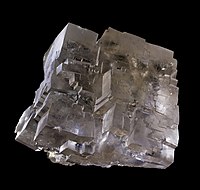
Photo from wikipedia
Abstract Corrosion is a major issue in industry, and the oxygen concentration in the fluids processed influences corrosion rates. Membrane contactors, such as Liqui-Cel® modules, are suitably used for de-aerating… Click to show full abstract
Abstract Corrosion is a major issue in industry, and the oxygen concentration in the fluids processed influences corrosion rates. Membrane contactors, such as Liqui-Cel® modules, are suitably used for de-aerating ultrapure water to low oxygen levels. Liquid mass transfer correlations for water de-aeration have been determined by varying liquid flow rates at ambient conditions. Limited information is available on membrane de-aeration of concentrated salt solutions. In our work the feasibility of membrane contactors for de-aeration of salt solutions containing 0.1–25 wt% NaCl has been investigated and confirmed. Oxygen outlet concentrations as low as 70 ppb have been obtained at a temperature of 40 °C and a (vacuum) pressure of 70 mbar using the Liqui-Cel® 2.5×8 Extra-flow module. Mass transfer coefficients have been determined for a range of liquid velocities, viscosities, densities, and oxygen diffusion coefficients by changing the salt concentration and the temperature. This means that not only the Reynolds number has been varied (as commonly done), but the Schmidt number as well. Their effect on the Sherwood number has thus been established. The obtained correlation allows sufficiently accurate prediction of oxygen removal from NaCl solutions over the entire salt concentration range. A membrane area of 455–4105 m2 (using Liqui-Cel® 14×40 modules) is required for de-aeration of a saturated sodium chloride solution to an oxygen concentration below 50 ppb using a total liquid flow of 100–900 m3/h, which is typical for salt production.
Journal Title: Separation and Purification Technology
Year Published: 2018
Link to full text (if available)
Share on Social Media: Sign Up to like & get
recommendations!